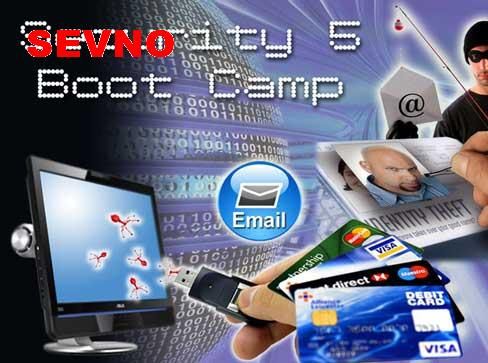

Security 5 Boot Camp Interactive course
616 MB
616 MB
Identity theft, credit card fraud, online banking phishing scams, virus and backdoors, email hoaxes, sex offenders lurking online, loss of confidential information and hackers are some of the threats you will face on a daily basis. Are you prepared to face them and defend yourself? If you are someone who banks online, pays utility bills online, shops online, have children chatting online, downloads shareware and games, communicates over email, subscribes to a broadband connection or someone who uses a computer system at work or home, then you need to have Security5 training to help you guard your information assets.
The course is targeted towards today’s knowledge workers who use computing resources in their daily activities. It educates them on practical aspects of security and networking to give them an advantage over common users.
Prerequisite
Basic computing skills like browsing the web and checking emails.
Who Should Learn:
* Office knowledge workers
* Home users
* Any person using computers in their office
Module 01: Foundations of Security
* Essential terminology
* Defining security
* Need for security
* Cyber crime
* Information Security statistics
* IS triangle
* Security myths
* How to harden security
Module 02: Basic Security Procedures
* Why do I need to worry about my computer’s security?
* Introduction
* Hardening of Operating System
* Updating the system and configuring the updates
* Disable unnecessary services
* Strong password creation
* Deployment of antivirus and firewall
* Disable guest account access
* “Make Private” folders
* Security settings in MS Office applications
Module 03: Desktop Security
* What is file sharing?
* Types of file sharing
* How to share folder?
* Configuring shared folder permissions
* Hiding files and folders
* File sharing tips
* File downloading tips
* How to backup data and restore?
* How to encrypt and decrypt files?
* How to kill suspect processes?
Module 04: Administering Windows Securely
* How to use the event viewer?
* How to enable auditing in windows?
* How to read logs on your system?
* How to close ports?
* Overview of the windows registry
* How to restore the registry?
* How to close a port?
* Common internal commands
* How to find services and ports they listen on?
Info
Download:
http://www.filesonic.com/file/971627811/Security_5_Boot_Camp_sevno.part1.rar
http://www.filesonic.com/file/971533641/Security_5_Boot_Camp_sevno.part2.rar
Mirror 1:
http://www.fileserve.com/file/YAqRdJA/Security_5_Boot_Camp_sevno.part1.rar
http://www.fileserve.com/file/nnfjQ6h/Security_5_Boot_Camp_sevno.part2.rar
Mirror 2:
http://www.uploadstation.com/file/mx9gexT/Security_5_Boot_Camp_sevno.part1.rar
http://www.uploadstation.com/file/HqFMxT3/Security_5_Boot_Camp_sevno.part2.rar
http://www.filesonic.com/file/971627811/Security_5_Boot_Camp_sevno.part1.rar
http://www.filesonic.com/file/971533641/Security_5_Boot_Camp_sevno.part2.rar
Mirror 1:
http://www.fileserve.com/file/YAqRdJA/Security_5_Boot_Camp_sevno.part1.rar
http://www.fileserve.com/file/nnfjQ6h/Security_5_Boot_Camp_sevno.part2.rar
Mirror 2:
http://www.uploadstation.com/file/mx9gexT/Security_5_Boot_Camp_sevno.part1.rar
http://www.uploadstation.com/file/HqFMxT3/Security_5_Boot_Camp_sevno.part2.rar







0 comments :
Post a Comment
BEFORE LEAVING THIS PAGE PLEASE take a moment FILL IN COMMENTS BOX